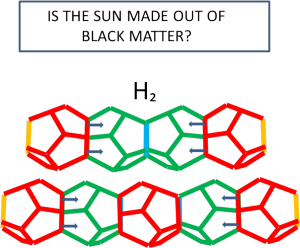The Sun and black matter
There are quite complex explanations for how the Sun originated.
The basic idea is that H atoms as residual fissionable material generated by the cataclysmic death of other stars came together in one or another way. The gravitational force induced compressing, the temperature went up, the H-atoms became ionized and lost their single electron. Subsequently, the Coulomb forces could destroy the early Sun, but obviously, that did not happen. No other counterforce available, the scientific assumption is that there is a threshold in temperature where the Coulomb force loses the ability to repel or something like that.
It is a rather complex explanation.
An alternative as a spin-off of The Dutch Paradigm has merits to consider:
It could well be that dark matter is the major constituent of the Sun.
A single dodecahedron is electrically neutral, but there is another twin-dodecahedron structure possible that is electrically neutral as well. It is a kind of “H₂” nucleus, in between an H-nucleus and a Helium nucleus
Forming of such twin protons of Hydrogen is likely in case electrons are not available to form an atom. It is well imaginable that this happened in the early stage of forming the universe when nuclei were in the plasma phase, and most electrons were in process to form dodecahedrons anyhow. Such a twin Hydrogen nucleus would be electrically neutral and has gravitational attraction. Once the gravitational effect becomes effective as a dominant force – in a more relaxed situation after forming the universe – it would start to clump these H₂ nuclei together into a very, very dense structure. Such a structure could absorb massive amounts of low energy photons as explained in the section on thermal expansion and thereby increase temperature. Eventually, this temperature and pressure could trigger the start of nuclear fission and fusion.
So far, this is not more than a suggestion to consider for further thinking, but it can trigger a better understanding of the forming of stars including our Sun and subsequent planets with the heavier elements.

